樋口 新葉
Wakaba Higuchi
Aspiring to create moving performances that truly reflect me
Taking a big step forwards by looking beyond solely achieving results
June 14, 2023
![Figure skater [Wakaba Higuchi]](/ito-sports-project/assets/img/interview/007/pct_mv.webp)
Interview: Takaya Hirano / Photos: Asako Toda
Becoming motivated for a second attempt

- ITO: I’ve heard you started skating when you were three years old. What do you enjoy most about skating? Why do you continue to compete?
-
Higuchi: It was my mother’s idea. She took me to a rink, and I took a skating class there. I later realized that the enjoyment of skating when I’d first begun had been so important for me. While in junior high school and high school, my goals shifted to winning competitions and mastering jumps. After moving on to university, I realized winning wasn’t everything. I started to treasure the joy I’d felt when I first started skating. And that change in my outlook improved my competition results. Training sessions became more enjoyable, too.
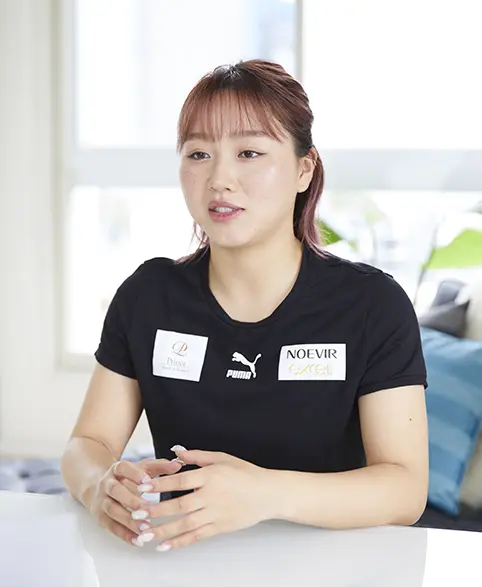
- ITO: What sparked the realization that winning isn’t everything?
-
Higuchi: The turning point was when I was a teenager. I didn’t qualify for a big international competition I’d set my sights on. I was too focused on the results. Skating started to feel like a chore. Around that time, I began to feel that maybe I needed something beyond competition results to help me view myself more positively. I started looking for that something. Then it struck me that I continued to skate because I enjoyed doing it. So I quit thinking just about producing the results others expected, and started practicing and setting goals in a way that was more for myself and more based on what I wanted to do. From that point on, things changed little by little.
- ITO: The sense of burning out that comes from a constant focus on results is a common story among athletes.
-
Higuchi: I still wanted to make it to that big competition. Participating at that level had always been a dream. But that second attempt was four years away, so it wasn’t enough to motivate me to give everything I had in the moment. I visualized myself working toward my second attempt by overcoming my weaknesses, year by year, leading up to the competition, while reveling in the joy and delight of gradually getting better.
I became depressed for about two months after missing out in the qualifier round, but I managed to qualify for an international competition in Milan scheduled three months later. This would be the last competition of the season, so I reset my thinking and decided I wanted to end the season in a way that would bring me satisfaction. Much to my surprise, I won the silver medal! That re-energized me and persuaded me it wasn’t all over. I started to see a gleam of light. Most importantly, I think my determination to get through the tournament in a way that made the most sense to me and the fact that this approach produced results are what spurred me to make my second attempt.
A personally authentic performance on the dream stage
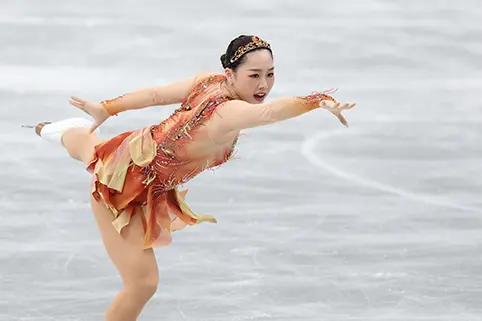
©Kiyoshi Sakamoto
- ITO: That second attempt at the international competition in Beijing in 2022 saw you help the team to the bronze medal in the team event. You also placed high enough to earn a prize in the individual event. In the free program, you fell on a consecutive triple jump, but in an interview afterward, you commented, “I felt that’s also an expression of who I am.” That left a powerful impression.
-
Higuchi: I really wanted to participate in the competition. At the previous year’s qualifying tournament, my attitude was that whether I qualified or not, I wanted to finish feeling satisfied with my performance. I’d practiced really hard and so could accept the outcome whatever it was, which gave me confidence.
-
In the three weeks leading up to the competition, I was only able to practice on the ice for 30 minutes a day, which was a new experience for me, and I had a hard time adjusting to it. And it was during the COVID pandemic, so we had to get tested every day and check to see which areas we were allowed to enter. I was really careful during the preparation stage. Being so tense, it was tough to get myself into tiptop condition. But I was able to get into good enough shape to achieve the goal I’d set of landing the triple axel (becoming only the fifth woman in history to do so at that competition) and to give it all I had in every other area. So I went into the competition with the attitude that the result wasn’t the most important thing.
Even if the results weren’t what those around me had hoped for, I felt satisfied. It was frustrating that I fell, but I managed to finish my performance without allowing negative thoughts and feelings to intrude. I felt I really grew. I felt not seeking too much in terms of results—and I mean that in a good way—had become a strength.
A change in performance brought on by grasping one’s own condition

- ITO: After you got back from that competition, you discovered you’d developed a fatigue fracture on the outside of your right shin. How have you dealt with injuries up to now?
-
Higuchi: I’d had chronic pain in my lower back, shins, and insteps since my elementary school days, but I’d never suffered major injuries like fractures or dislocations. Back then, I was told I was prone to pain because my body was still in the growth stage and my bones hadn’t hardened yet. The year I won the silver medal at the international competition mentioned earlier, I hurt my instep so badly I had to withdraw from a competition I was set to compete in. Until then, I’d never suffered injuries serious enough to keep me from competing.
- ITO: When did you become aware of the importance of conditioning?
-
Higuchi: Up until junior high school, I just did what I was told by the adults around me. I didn’t know anything about my own condition. I didn’t even try to find out about it. Once I got to high school, based on conversations with the skaters around me, athletes in other sports, trainers, and coaches, I learned each had their own way of doing things. I started to find it interesting enough to do my own research. I became interested in how my condition would affect my performance in competitions. I started telling my trainers about my condition, listening to their advice, and making adjustments.
Since my hours training on the ice differ day to day, my life tends to be a bit irregular. But now that I can track my physical condition, I can make predictions even for the same day. Based on the practice I do in the morning, I can tell what my condition will be in the afternoon, which helps with scheduling my days. Now I enjoy monitoring things in detail. I even weigh meals down to the last gram.
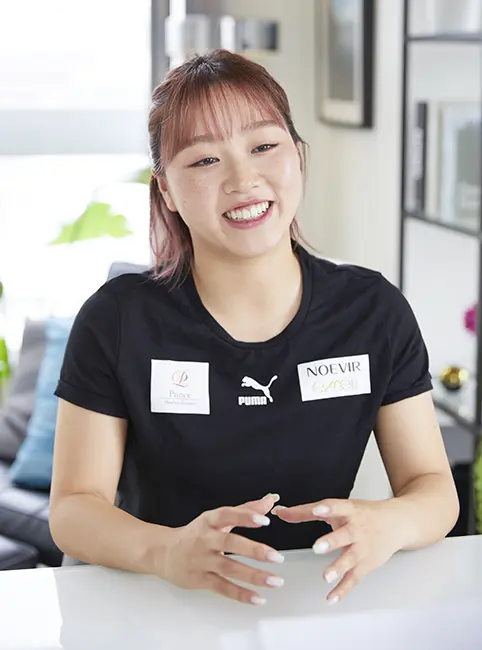
- ITO: Could you give us some examples? What sorts of things have what sorts of effects?
-
Higuchi: My feeling is that depending on things like how you eat, there are times when you can move your body more easily and times when it’s harder. Nutrients also affect how much you sweat. Some people say they can only move after eating. But right now, I find I can concentrate better and move more easily when I’m hungry. So I decided not to do jumps—which are more physically demanding—during morning practice, and to do them in the afternoon. And I organize my meals accordingly. When a competition is coming up, I schedule my practice to match the time I’ll perform in the competition. Additionally, recovery is crucial, so I always take a nap between the morning and afternoon sessions.
Treatment device is a source of reassurance
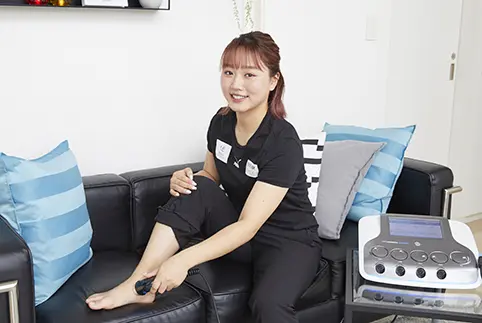
- ITO: You said that you’d had chronic pain since childhood. What did you do in terms of self-care and treatment?
-
Higuchi: From my elementary school days, I imagined whatever treatment center I went to, there’d be an ultrasound treatment device there and they’d use that on me. For self-care, I’ve always used microcurrent. I apply it mainly to my legs, to injured areas and to painful areas I’m worried for recovery. I normally use it lying down to condition myself for the next day.
-
With many of my injuries, like the fatigue fracture, there’s no clear sign of full recovery. The effects of the treatment device aren’t obvious. But my impression is that using it every day speeds up recovery. And because it’s small, I always take it with me when I go overseas.
I apply ultrasound on my own when I can’t get to a treatment center. I often use it on my knees, where muscles and tendons are prone to strain. The device has various modes. I use it to treat not just my bones, but my muscles. I use it on every part of my body, not just my legs. I also use it proactively to encourage closing of a post-operative wound and things like that.
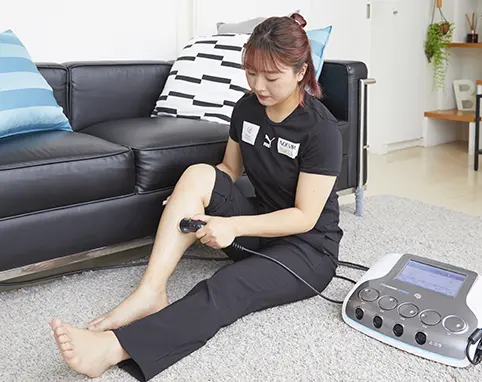
- ITO: Can you tell us about situations where you were glad you had the treatment device?
-
Higuchi: I was runner-up in the 2017 Japan Championships, but I injured my knee during the period of the competition. I packed in a lot of practice in the month or so just before competing. The knee injured during the period did not fully recover, and it might have kept hurting and got worse. But I used the ultrasound treatment device while getting advice on how best to use it. I was in pretty good shape by the time of the competition. The results I achieved were good. The device was a real asset.
-
After the discovery of the fatigue fracture in my right shin in 2022, I had to go easy for a long time to ensure full recovery. Even so, I still had to skate a bit as I continued with treatment. So I used the ultrasound treatment device to help with recovery after practice.
The treatment device gives me peace of mind. When I’m anxious, it’s great to be able to say to myself, “I have this, so everything’s going to turn out alright.” I try not to make too many changes in the way I use it. Because, if I do, I start wondering whether any change in my body is down to using or not using it this or that way. So I make a deliberate effort to use it the same way every day for 20 to 30 minutes.
A personally authentic approach to skating without fixation on results

- ITO: We hear you’re returning this season. What are your future goals?
-
Higuchi: For starters, my goal is to achieve my best performance at the Japan Championships this year (2023). If I can do that, I’ll have a shot at the international competitions. Right now, I’m not concerned about things like pain, to the extent that I believe I can probably return to my previous level. Even the most taxing practice is fun and fulfilling. I hope I can take these positive feelings with me into competitions.
I’ll be targeting results because the reality is that producing results presents lots of different opportunities to succeed in life. But, as I said at the start of this interview, other things matter. I want to be the kind of skater who delights and moves people through personally authentic skating and performances—rather than focusing only on the result. Displaying my emotions during performances is something I’ve practiced a lot and feel confident about. So I hope those emotions reach those who watch me.
Recently, I sometimes think about trying ice dancing as well. I’ve always skated in singles, so I’ve never skated with someone else. I love taking steps, so I think it’d be interesting to make turns at the same tempo as another skater, or to be lifted up. At any rate, in the future I want lots of people to see me skate, not just in competitions but also in, say, ice shows, for as long as I can still skate.
![Figure skater [Wakaba Higuchi]](/ito-sports-project/assets/img/interview/007/pct_bio.webp)
Born January 2, 2001 in Tokyo. Affiliated with Noevir.
She began skating at the age of three. Still a novice, she was allowed to participate in the Japan Junior Championships (by recommendation) and placed eighth. She was invited to skate in the exhibition galas at the NHK Cup and World Championships.
In 2016, she took third place at the World Junior Figure Skating Championships for the second year in a row. Despite missing out on the PyeongChang Olympics by a whisker, she continued to perform well in numerous domestic and international competitions. In the 2021 Japan Figure Skating Championships, the results of which would determine who was selected for the Beijing Olympics, she placed second, thereby earning a spot on the national team for the Games.
At the Beijing Olympics, she came third in the team competition and fifth in the individual.
